Photo #: NH 56668
USS Black Hawk (ID # 2140)
Scene on deck during a noon hour, circa 1918-1919, with band
playing and crewmen relaxing.
Note life ring, marked "U.S.S. CK H".
U.S. Naval Historical Center Photograph.
Online Image: 115KB; 740 x 555 pixels |
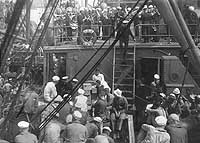 |
Photo #: NH 101173
USS Black Hawk (ID # 2140)
Band concert for the ship's crew, 1919, during the sweeping of
the North Sea mine barrage.
Note the minesweepers moored in the background. USS Heron
(Minesweeper # 10) is at left, with the identification letter
"U" painted on her bow.
Collection of Charles F. Speraw, courtesy of him and of William
V. Kennedy, 1986.
U.S. Naval Historical Center Photograph.
Online Image: 130KB; 740 x 480 pixels |
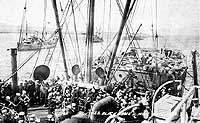 |
Photo #: NH 56669
USS Black Hawk (ID # 2140)
A giant halibut caught near the Orkney Islands in 1919, while
Black Hawk was supporting the sweeping of the North Sea
mine barrage. This one fish was sufficient for a meal for the
entire crew.
Note that a smaller, darker colored, halibut is also attached
to the line.
U.S. Naval Historical Center Photograph.
Online Image: 84KB; 545 x 765 pixels |
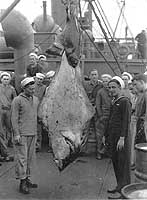 |
Photo #: NH 56672
USS Black Hawk (ID # 2140)
Boats tied up astern of the ship, during rough weather in a British
port, circa 1918-1919.
U.S. Naval Historical Center Photograph.
Online Image: 70KB; 740 x 445 pixels |
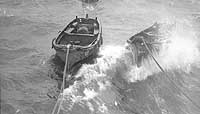 |
Photo #: NH 56670
USS Black Hawk (ID # 2140)
Rear Admiral Joseph Strauss (front row, center), Commander of
the North Sea mine barrage clearance operation, on board the
ship with other officers, 1919.
Note that a few of these officers are wearing the newly-introduced
open collar double-breasted uniform jacket.
U.S. Naval Historical Center Photograph.
Online Image: 91KB; 740 x 530 pixels |
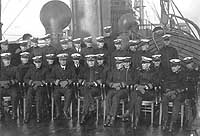 |
Photo #: NH 56674
USS Black Hawk (ID # 2140)
Rear Admiral Joseph Strauss leaving the ship at Gravesend, England,
probably in October 1919. Black Hawk was his flagship
during and after World War I, when he was Commander Mine Force,
Atlantic Fleet.
Note that RAdm. Strauss is wearing the newly-introduced open-collar
double-breasted uniform jacket.
U.S. Naval Historical Center Photograph.
Online Image: 78KB; 740 x 485 pixels |
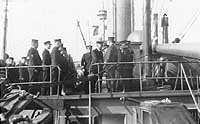 |
Photo #: NH 44211
Rear Admiral Joseph Strauss, USN
On board USS Black Hawk (ID # 2140) on 21 November 1919,
when she returned to the U.S. from British waters. The ship was
Strauss' flagship during the clearance of the North Sea mine
barrage earlier in the year.
U.S. Naval Historical Center Photograph.
Online Image: 55KB; 510 x 765 pixels |
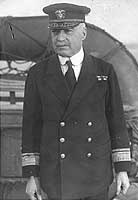 |
Photo #: NH 53062
USS Black Hawk (ID # 2140)
"Crewmembers smiling now that they have returned to home
waters after two and a half years as part of the U.S. minesweeping
fleet, 23 November 1919." (quoted from the original 1919-vintage
caption)
Black Hawk initially deployed to the British Isles in
June 1918 and returned to the U.S. in November 1919, a period
of nearly one and a half years.
U.S. Naval Historical Center Photograph.
Online Image: 87KB; 740 x 570 pixels |
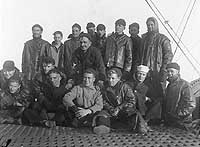 |
Photo #: NH 99693
USS Black Hawk (ID # 2140)
Ship's crew on deck, off New York City on 24 November 1919.
Halftone reproduction of a panoramic photograph, published in
the cruise book "Sweeping the North Sea Mine Barrage, 1919",
page 98.
Donation of Chief Storekeeper Charles A. Free.
U.S. Naval Historical Center Photograph.
Online Image: 62KB; 740 x 245 pixels |
 |
